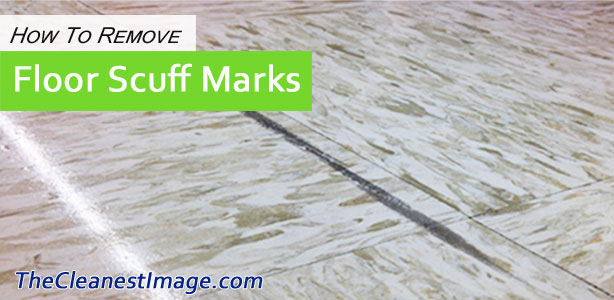It is a very common issue in floor care… how to remove scuff marks from floors. Lets face it, you see them on almost every finished floor. Nothing is more frustrating than to take the time to get a floor looking great with high shine and then walk in only to see back scuff marks everywhere.
Over the years, I have asked everyone from floor care experts with decades of experience to the chemists that create floor finish for the manufacturers, why these black marks are such a problem, but have gotten mixed answers.
I have taken all of those opinions and combined them with my experience to provide you with a quick explanation of what causes black scuff marks and how to remove them.
What Causes Scuff Marks On Floors?
Typically black scuff marks on a floor come from shoe soles or rubber wheels . When shoes and wheels create friction with the floor, some of the rubber melts and is left on the floor. This is why even a highly polished floor will attract scuff marks. In fact, a glossy floor is designed to provide maximum traction to prevent slip and falls. This friction ends up causing shoes to grab the surface of the floor and leave some of the shoe sole behind.
Because of this, you may have also noticed that scuff marks are easier to remove from a highly polished floor. It is like peeling paint from a smooth surface rather than a textured one. The smoother the surface, the easier it is to peal. The residue from the shoe sole kind of works the same way on the floor.
Automatic Scrubbers and Removing Floor Scuff Marks
Automatic floor scrubbers are an absolutely invaluable resource when it comes to cleaning floors. They not only make the work much easier but also do a much better job removing dirt. That being said, it would seem that the scrubbing action and cleaning chemicals would remove scuff marks. Unfortunately though, this is not usually the case.
Often the scrubbing of the pad or brush and floor cleaning chemicals are not effective for removing scuff marks from floors. This is because the scuff marks, being residue from plastic soles, are not affected by the wet, plastic floor pads used for cleaning.
Automatic floor scrubbers are generally for removing dirt that has been tracked in, or surface soils. These respond to the scrubbing action and/or react to floor cleaner.
Since scuff marks are made up of melted rubber or plastic. Essentially, they are a solid substance that has melted and bonded to the floor. Because it is friction that left the mark on the floor, it will take friction to remove it.
When an automatic floor scrubber passes over these marks, the water that it applies to the floor reduces heat and friction. So the compounds from the shoe sole are not affected by the agitation of the brush or pad.
Basically it passes right over them.
The best manual method I have used is a damp microfiber flat mop, like this one from Amazon or magic sponge pad. Just simply wipe across the scuff and they disappear. This can be time consuming though. Whenever possible, use mechanized equipment to speed up the process.
Remove Scuff Marks With Cleaning Chemicals
So if scrubbing the floor doesn’t work, why won’t the floor cleaning chemicals work? Well the short answer is some do. When you use a neutral floor cleaner, these chemicals are designed to loosen organic soils, not petroleum based soils. They virtually have no affect on plastic of rubber. This is why we use them. They don’t harm the floor finish, a.k.a. plastic coating.
Many cases the pH of a ‘heavy duty’ floor cleaner will be higher than neutral or ‘8.’ You will typically find them in the range of a 9 pH. This added alkalinity works well to remove oily films and will also some what work to dissolve the shoe sole residue, but there is a downside to using them as a regular cleaner.
They also soften the floor finish. Because floor stripper is also on the alkaline side of the pH scale, anything above a pH of 8, is breaking down the floor finish.
So if you use these ‘heavy duty’ floor cleaner very often, you will quickly see the finish begin to grab and hold dirt. This will shorten the re-coat cycle.
So How Do You Remove Them?
The best way I have found to remove these scuff marks is with a high speed burnisher. Because the machine creates heat from the dryer conditions and higher speed, the black marks simply are rubbed away. There are even burnishing pads specifically designed for this. I have found that as long as the floor is clean, a natural fiber pad works pretty well. You can find these here, on Amazon.
It is important to note that you should always dust mop the floor after burnishing, especially if you have a lot of black scuff marks. Dust and dry debris that is left after burnishing can not only damage the floor, but is breathable!
The reality of controlling scuff marks is to have a good floor cleaning program. Then, follow it up with a regular burnishing program that not only keeps the floor shiny, but smooth to make scuff marks easy to remove.
